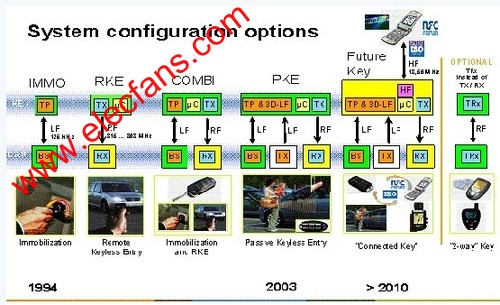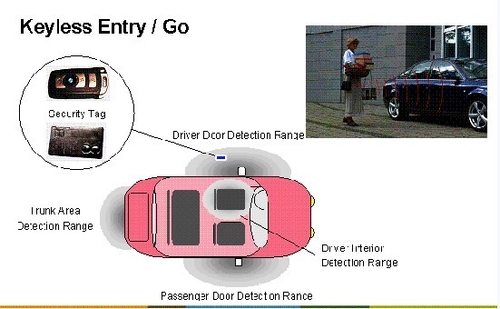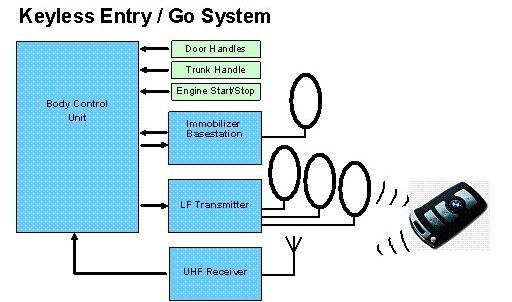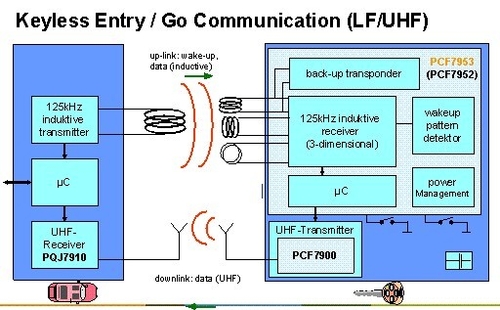The remote control key (RKE) brings a good user experience to people and meets people's requirements for convenience and comfort, but due to the technical limitations of its radio frequency one-way communication, it has its own shortcomings in security. The integrated solution (Combi) launched by NXP Semiconductors (hereinafter referred to as NXP) in a timely manner combines the engine anti-theft and remote control keys into one, which is realized by a single chip, which not only improves the security of the system, but also reduces the cost of the entire key. Gradually replacing independent remote control keys has become the mainstream solution in the European, American and Japanese markets. Of course, it still retains one-way communication on radio frequency communication, and the security has not been substantially improved.

In 2003, NXP launched a keyless system (PKE or PEPS), which completely changed the development prospects of automotive security applications and brought users a new comfortable and convenient experience: car owners do not need to use keys during the entire driving process. , Just need to carry it with you. When the owner enters the effective range near the car, the car will automatically detect the key and identify the identity, if successful, the door or trunk will be opened accordingly; when the owner enters the car, just press the engine start button, the car will automatically detect the key Position, determine whether the key is in the car, whether it is in the main driving position, if successful, start the engine. Don't underestimate this seemingly insignificant change, it plays a major role in simplifying your life. The keyless system not only brings comfort and convenience, but also has an essential improvement in security. Through two-way communication of low frequency and radio frequency, complex two-way identity authentication can be completed between the car and the key. In terms of security Similar to engine anti-theft, it is much better than traditional remote control keys. Since the successful mass production of keyless systems for a small number of high-end models in 2003, the global market has spent two to three years promoting the popularization of this technology. At present, almost every mainstream car manufacturer in the world has NXP keyless products, covering mid- to high-end Models, even low-end models.
Let's take a look at how this technology is implemented. As shown in Figure 2, the keyless system needs to detect and judge three types of areas: a gray exterior area, a pale pink interior area, and an off-white main driving position. The gray shaded area includes three parts, which represent the effective area of ​​the door control of the main driver, the co-driver, and the trunk. When the owner enters this position with the key, effective communication can be established between the car and the key, through the low-frequency signal In the field strength detection, the car can determine the corresponding position of the key, thereby deciding to open the corresponding door. The light pink interior area is the difficulty of the entire PKE system design. It is necessary to accurately determine whether the key is in the vehicle to determine the door status and whether the engine can be started. In the design of some high-end models, it will also detect the off-white main driving area, whether the key is valid, whether there is a main driving position, to avoid engine startup caused by children ’s misoperation, and may also include detection of the area in the trunk to prevent keys It was accidentally locked into the trunk.

In summary, we can find that in the keyless system, area detection is a very important technology that is different from various automotive security products in the past, so the accuracy of area detection has become an important parameter to measure the quality of a keyless system. At present, there are two main technologies on the market. One is to adjust the sensitivity of the low-frequency signal to make a fuzzy judgment based on whether the communication is stable. Its accuracy is limited but it is convenient to implement. The second is to judge based on the strength detection of the received low-frequency signal. RSSI (Received Signal Strength IndicaTIon), calculates the relative distance between the key and the low-frequency antenna in the car according to the size of the low-frequency signal, and accurately locates the specific position of the key through the cross-coverage of multiple low-frequency antennas. NXP products all use the second technology. In order to achieve the ideal performance parameters, NXP provides a minimum 2.5 mV three-dimensional low-frequency reception signal sensitivity of the front end, and the typical sensitivity value can reach 1mV. Different from the successive approximation (Successive ApproximaTIon) ADC of other solutions, NXP adopts 12-bit Sigma-Delta (Σ-Δ) ADC to eliminate noise interference through multi-point sampling averaging. The best in-vehicle car has been realized so far. The external detection accuracy is up to 2cm. At present, the detection accuracy usually required by the car manufacturer is 5 to 10 cm.
The block diagram of the keyless system is shown in Figure 3. The left side is the car end, including the main controller (Body Control Unit), the door handle and trunk handle trigger module, the engine one-key start module, and the engine anti-theft base station module (IMMO BasestaTIon ), Low-frequency transmitter module and radio frequency receiver module. Three of the green modules are mainly used to trigger the entire system. When the owner pulls the door or presses a key to start the button, the corresponding module will send an interrupt signal to wake up the main control MCU and start the entire communication process. Common keyless system working modes are divided into two categories: trigger mode and scanning mode (polling), where the trigger mode is divided into mechanical trigger and electronic induction trigger, here need to comprehensively consider the system cost and system performance, such as the response time of the entire system. The engine anti-theft base station module is a low-frequency communication module (125KHz), which is used to achieve short-range communication with the key and start the engine. This function is a backup solution, also known as "no power mode", only when the key battery is exhausted or there is unexpected interference It is only used when the keyless system can not work normally. In this case, the user only needs to hold the key in a fixed position (such as a groove), and the key can establish communication with the base station and perform identity authentication to start the engine. A key feature of NXP's keyless systems PCF7952 and PCF7953 is that the chip itself integrates the engine anti-theft function and is fully compatible with all NXP Transponder products, including PCF7936. This greatly improves the reliability of the system without additional cost, specific details will be mentioned later.

The low-frequency transmission module and the RF receiving module are the basic communication links of the keyless system. The low-frequency transmission uses 125KHz, which is the uplink, and is sent from the car end to the key end. Send to the car. The reason why 125KHz is used is on the one hand to be compatible with engine anti-theft technology, and more importantly, the 125KHz signal is sensitive to distance, which can realize accurate distance detection and play a key positioning role. The radio frequency uses the traditional RKE frequency band. On the one hand, it is compatible with the basic functions of the remote control key, and it also takes advantage of its fast communication speed. What needs to be highlighted here is that the so-called communication speed refers to the data used for authentication and encryption between the key and the car. Transmission, in order to ensure that the keyless door opening or ignition process is completed in a short period of time, a higher baud rate (generally 8 to 20 kbps) is required, and it is generally not recommended to use a low-end SAW transmitter module (about 1 kbps), and Adopt the launch chip based on phase-locked loop technology to realize, such as PCF7900 of NXP, its maximum baud rate can reach 20kbps in FSK mode. Also for this purpose, the radio frequency band also tends to use higher frequency 868MHz or 915MHz. As shown in the figure, the low-frequency transmitting module includes multiple low-frequency antennas, which are installed in the door handle of the vehicle to achieve keyless entry (Keyless Entry), and installed inside the vehicle body to implement keyless entry (one-key start Keyless Start).
The specific block diagram of the key end is shown in Figure 4. The main chip is NXP's PCF7952 or PCF7953, the radio frequency transmitting chip is NXP's PCF7900, and the corresponding radio frequency receiving chip at the car end is NXP's PQJ7910. PCF7952 / 53 has a low-frequency analog front end (LF Front End) for connecting peripheral 3D antennas. In the keyless system, the key end needs an external 3D low-frequency antenna, which can receive and detect the 3D energy field strength of the external space, respectively X, Y, and Z axes. By superimposing the energy in 3 directions, the key can be guaranteed at any angle Can detect the same field strength. The one-axis antenna is also multiplexed into the function of IMMO, enabling the engine to start in the no-electric mode. Through the uplink and downlink, the key can establish two-way communication with the car for complex identity authentication. The latest generation of authentication technology is called Mutual-AuthenTIcation. It not only requires the car to authenticate the key, but also needs the key to determine whether the car is legal. Any error will lead to the end of the entire communication to ensure the security of the system . The communication distance is determined by the low-frequency uplink 125KHz. The normal effective working distance of the PKE system is about 2.5m, and the actual effective door opening and closing distance is 1.5m ~ 2m. In addition to the detection accuracy inside and outside the car, the power consumption of the key end is also an important indicator to measure the quality of a keyless system. The power management module included in the PCF7952 can minimize the power consumption of the entire system. A mature keyless system solution, key In the case of a 2032 3V lithium battery, the battery life can be up to three years.

After the keyless system, where will car security and anti-theft products go? NXP has given the exact answer: Keylink, the next generation of car keys. Its biggest breakthrough lies in connecting the car key to peripheral smart terminals, so that the key can be connected to devices such as mobile phones, PDAs and other devices at close range. With the help of the display functions and powerful processing capabilities of smart terminals such as mobile phones, a Incomparably vast application space is before us:
Inquire about the status of the vehicle, the status of the doors and windows, the amount of fuel in the fuel tank, the temperature in the car at any time ... the display on the mobile phone screen is everything.
Looking for a car, through the cooperation of the key and the mobile phone, the GPS navigation of the mobile phone helps you easily find the parking place.
Easily formulate travel routes, save the selected travel route in the key in front of the computer. When entering the car, the car navigation system will automatically import travel information.
Vehicle maintenance, vehicle factory records, and maintenance records are all stored in the key for easy maintenance.
24 port PoE 10/100/1000M managed network switch/POE Switch/10/100/1000M 24 port POE
Managed POE Switch is designed for Video surveillance and network project system,etc.it provides 24x100Mbps Ethernet ports; 2x10/100/1000Mbps ports &2x1000 Base-X SFP optical fiber port as uplink ports; supports Web& CLI management,two layer network management and POE Intelligent management; supports data wire-speed and Jumbo Frame forwarding .Port based VLAN function can effectively prevent whole system from broadcast storm so that make the date transfer safer.The 16*10/100Mbps POE Switches complies with IEEE802.3 af/at standards,it simplifies wiring,avoids the troublesome of installing power socket for powered devices,such as
Features:
- Provide 24x 100Mbps ports; 2x10/100/1000 Mbps port & 2x1000 Base-X SF Poptical fiber port as uplink ports
- Support End-Span method,complies with IEEE802.3 af/at standards,flexibly configures power for each port.
- Support L2 switching function,including 802.1QVLAN,port mirroring, port isolation,IGMP Snooping function.
- LLDP,POE+Management and ARP detection.
- Support WEB,CLI,TELNET&SNMP management
- Support 10K Jambo Frames
- Support STP(802.1D) and RSTP(802.1W)
- Support IEEE802.3x full-duplex flow control,support Auto MDI/MDIX
- Restart funtion helps master IC reset wholly,Easy for users to solve network failure
- Without swapping power supply,easy to maintain system,help monitoring pictures ,recover quickly.
- Excellent lighting protection,lightning capacity up to 2KV.
Application:
- Security Monitoring system
- Multimedia Network Teaching System
- Medical Monitoring Display System
- Industrial Automation Control System
- Banking ,securities,financial information display system
- Remote Network Server Monitoring
- Department Store Security
- Casino Security
- Hospitals,Airports and banks
- School Campuses
Gigabit Standard Managed Poe Switch
Gigabit Standard Managed Poe Switch,8 Port Poe Switch,250M Poe Transmission,Giga Managed Power
Guangdong Steady Technology Co.LTD , https://www.steadysmps.com